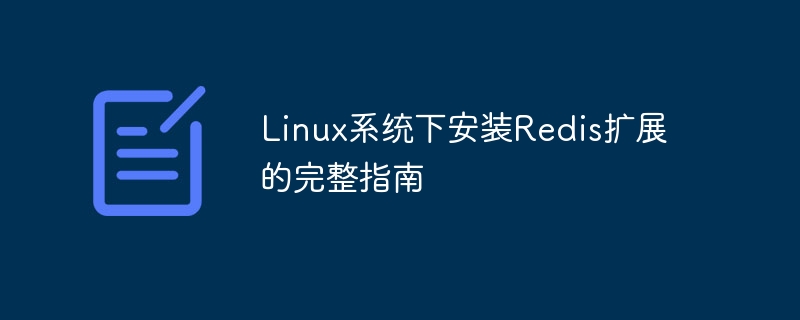A complete guide to installing Redis extensions on Linux

Complete guide to installing Redis extensions under Linux system
Redis is an open source, high-performance key-value storage database that is widely used in Scenarios such as caching and message queues. Installing the Redis extension under the Linux system allows us to use the Redis database more efficiently. This article will introduce in detail how to install the Redis extension under Linux system and provide specific code examples.
Step 1: Install Redis
- Open the terminal and use the following command to install the Redis server:
sudo apt update sudo apt install redis-server
- Start the Redis server:
sudo systemctl start redis-server
- Confirm that the Redis server has been started:
sudo systemctl status redis-server
Step 2: Install the PHP extension
- Open the terminal and use the following command to install Redis extension for PHP:
sudo apt-get install php-redis
- Open the PHP configuration file and add the Redis extension:
sudo nano /etc/php/7.4/cli/php.ini
Add the following content at the end of the file:
extension=redis.so
Save and exit.
- Restart the PHP service:
sudo systemctl restart php7.4-fpm
Step 3: Test the Redis extension
- Create a PHP file, such as
test_redis. php, enter the following code:
<?php
$redis = new Redis();
$redis->connect('127.0.0.1', 6379);
$redis->set('test_key', 'Hello, Redis!');
echo $redis->get('test_key');
?>- Execute the PHP script:
php test_redis.php
If everything goes well, Hello, Redis! , indicating that the Redis extension has been successfully installed and connected to the Redis server.
Summary
Through the above steps, you have successfully installed the Redis extension under the Linux system and conducted a simple test. Now you can use Redis database in PHP projects to improve performance and efficiency. Hope this article is helpful to you!
The above is the detailed content of A complete guide to installing Redis extensions on Linux. For more information, please follow other related articles on the PHP Chinese website!

Hot AI Tools

Undresser.AI Undress
AI-powered app for creating realistic nude photos

AI Clothes Remover
Online AI tool for removing clothes from photos.

Undress AI Tool
Undress images for free

Clothoff.io
AI clothes remover

Video Face Swap
Swap faces in any video effortlessly with our completely free AI face swap tool!

Hot Article

Hot Tools

Notepad++7.3.1
Easy-to-use and free code editor

SublimeText3 Chinese version
Chinese version, very easy to use

Zend Studio 13.0.1
Powerful PHP integrated development environment

Dreamweaver CS6
Visual web development tools

SublimeText3 Mac version
God-level code editing software (SublimeText3)

Hot Topics
 Linux Architecture: Unveiling the 5 Basic Components
Apr 20, 2025 am 12:04 AM
Linux Architecture: Unveiling the 5 Basic Components
Apr 20, 2025 am 12:04 AM
The five basic components of the Linux system are: 1. Kernel, 2. System library, 3. System utilities, 4. Graphical user interface, 5. Applications. The kernel manages hardware resources, the system library provides precompiled functions, system utilities are used for system management, the GUI provides visual interaction, and applications use these components to implement functions.
 How to run java code in notepad
Apr 16, 2025 pm 07:39 PM
How to run java code in notepad
Apr 16, 2025 pm 07:39 PM
Although Notepad cannot run Java code directly, it can be achieved by using other tools: using the command line compiler (javac) to generate a bytecode file (filename.class). Use the Java interpreter (java) to interpret bytecode, execute the code, and output the result.
 How to check the warehouse address of git
Apr 17, 2025 pm 01:54 PM
How to check the warehouse address of git
Apr 17, 2025 pm 01:54 PM
To view the Git repository address, perform the following steps: 1. Open the command line and navigate to the repository directory; 2. Run the "git remote -v" command; 3. View the repository name in the output and its corresponding address.
 laravel installation code
Apr 18, 2025 pm 12:30 PM
laravel installation code
Apr 18, 2025 pm 12:30 PM
To install Laravel, follow these steps in sequence: Install Composer (for macOS/Linux and Windows) Install Laravel Installer Create a new project Start Service Access Application (URL: http://127.0.0.1:8000) Set up the database connection (if required)
 What is the main purpose of Linux?
Apr 16, 2025 am 12:19 AM
What is the main purpose of Linux?
Apr 16, 2025 am 12:19 AM
The main uses of Linux include: 1. Server operating system, 2. Embedded system, 3. Desktop operating system, 4. Development and testing environment. Linux excels in these areas, providing stability, security and efficient development tools.
 How to use the Redis cache solution to efficiently realize the requirements of product ranking list?
Apr 19, 2025 pm 11:36 PM
How to use the Redis cache solution to efficiently realize the requirements of product ranking list?
Apr 19, 2025 pm 11:36 PM
How does the Redis caching solution realize the requirements of product ranking list? During the development process, we often need to deal with the requirements of rankings, such as displaying a...
 git software installation
Apr 17, 2025 am 11:57 AM
git software installation
Apr 17, 2025 am 11:57 AM
Installing Git software includes the following steps: Download the installation package and run the installation package to verify the installation configuration Git installation Git Bash (Windows only)
 Laravel8 optimization points
Apr 18, 2025 pm 12:24 PM
Laravel8 optimization points
Apr 18, 2025 pm 12:24 PM
Laravel 8 provides the following options for performance optimization: Cache configuration: Use Redis to cache drivers, cache facades, cache views, and page snippets. Database optimization: establish indexing, use query scope, and use Eloquent relationships. JavaScript and CSS optimization: Use version control, merge and shrink assets, use CDN. Code optimization: Use Composer installation package, use Laravel helper functions, and follow PSR standards. Monitoring and analysis: Use Laravel Scout, use Telescope, monitor application metrics.






